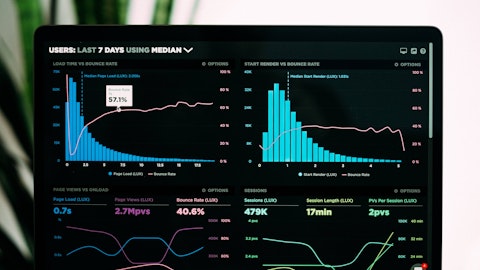Bret Jordan: Okay. I guess from the forecast on cash flow for the year, where do you see the payables ratio getting down to? I guess as we add another couple of EBIT quarters that might have your leverage ratio above 3?
Tony Iskander: Yes. As you saw from Q1 to Q2, it’s starting to go up. And we expect it to continue to increase over time as we get some of those investments, behind us and then we continue to build and replenish. So, we actually believe that the AP ratio will continue to expand.
Bret Jordan: Okay, great. Thank you.
Tom Greco: Thanks, Bret.
Operator: Thanks, Bret. Our next question comes from Seth Sigman from Barclays. Seth, your line is now open. Please go ahead.
Seth Sigman: Hi, good morning, everyone. I wanted to follow-up on the gross margin. It sounds like part of the issue is pricing to cover the costs, but I’m curious, why is that so different for AAP? And I’m curious, are you still seeing incremental cost pressures in COGS, or is this really a function of — you had elevated product and supply chain costs last year. Some of that was capitalized into inventory or on the balance sheet. It’s just flowing through now as the inventory turns. And if that’s right, do you have visibility into when that starts to normalize through this year?
Tom Greco: I think that the earlier question sort of answered that one, Seth, which is, we did see our pricing elevate above the market in the back half of last year, and we are addressing that as we go into this year. And you’ll see that through the back half. So, we’re committed to holistic solution here. We want to make sure availability gets better. Our visibility of our parts is better, and service and delivery continues to improve. And, we are going to sustain the price index. We’ll continue to stay focused on that. But as we get into, obviously, further out, you’ll see that normalize.
Seth Sigman: Okay. So, if we look at the EBIT margin outlook for the second half of the year, you did lower it, but it looks like the year-over-year change will be down less than, I guess, in the first half of the year. Can you just help us contextualize what may be driving that improvement trend in the second half of the year?
Tom Greco: Yes, sure. I mean, for sure on the gross margin side, we mentioned freight earlier. Freight becomes a tailwind for us in the back half. Some of our category management initiatives begin to benefit us in the back half. And just year-over-year, price versus cost is not as a punitive, as it was in the front half of the year. We’ve got more sales. So, there’s less supply chain, the leverage on the gross margin side. As we said, SG&A is smaller. We’re going to have, be slightly above last year’s rate on SG&A, which involves the investments we’re making in our team to make sure that we reduce turnover in the stores and really keep all the great people we have here in the corporate office. So, those are the two drivers, and both of them are going to get better than they were in the front half.
Seth Sigman: Got it. Alright. Thank you.
Operator: Thanks, Seth. Our net question comes from Steven Zaccone from Citigroup. Steven, your line is now open. Please go ahead.
Steven Zaccone: Great. Good morning. Thanks very much for taking my question and, congrats on the CEO announcement. I guess, Gene, my question is for you. As you take a more active role in the business, I’m curious for your assessment of how long it will take for this business to return to profitable growth. I know Shane will come in and it seems like he has a lot to figure out. But from your seat, do you think of this as a one year invest-to-grow margin strategy, or is this something that’s more multi-year in nature?
Gene Lee: Well, I think it’s less than one year. I mean, I think that, we should start seeing incremental improvement, pretty quickly here. There’s some really good actions that are being taken right now, especially around the operational front. I think we’re doing a much better job today up and down the street with our professional customers. I think we’re operating at the store level much better. I think we’re making significant improvements in supply chain. And more importantly, I think, when you think about our strategy with our top 4000 products that we’re calling never out, we’ve made great progress there too. So, I think that we are — I think that the price-to-inflation gap will continue to grow. And as we move forward, we should actually be able to price to cover inflation after we wrap.
Therefore, you’re not going to see the same kind of deleverage in the gross margin line. And so I think that we’re going to start seeing improvement pretty quickly. We’ve been working hard the last 90 to 120 days on some, I think some focused initiatives that are starting to come through for us. We’re seeing that in the sales line. We’re excited every morning that we’re seeing some sales growth. So, I think as we get past the back half of the year, we will actually see price at inflation or slightly above inflation, and then we can get to start to leveraging both gross margin and gross profit and our SG&A.
Steven Zaccone: That’s great. Thank you for that detail. And then, just to follow-up because there’s been several questions clearly Worldpac, but I was curious with the operational and strategic review. Is it fair to conclude that includes the potential for asset divestitures?
Gene Lee: I think there’s a range of options, that we have to consider. We sit here today, we think Worldpac is a great asset. And as I think about all our assets, I think the number one issue in our organization today is asset productivity. So, we need to evaluate the productivity of all of our assets, including Worldpac. We need to understand what’s the potential of all those assets? How do they fit organizationally? And how to best operationalize those assets? To me, that’s what the comprehensive, strategic review is all about. And I think there’s going to be more focus on the operational review because we have a lot of opportunity there to improve our processes and procedures from end-to-end. And I think that’s really over time where the cost savings will come is through improving those processes and procedures.
And I think Tom, mentioned earlier, and we’re working hard on our category management. We have an outside consultant working with us, and we’re making some really great progress that I think will show some positive results into 2024. And I’m excited about that, but there’s other opportunities. And what I’ve been referring to as the value chain, to evaluate all our processes and procedures. So, I would say we have a wide range of options. Everything is on the table but I think we need to truly understand Shane needs to truly understand what’s the potential of all these assets and how do they fit in and how we best operationalize them.
Steven Zaccone: Great. Thank you for all the detail. Best of luck.
Operator: Thanks, Steven. Our next question comes from Steven Forbes from Guggenheim Partners. Steven, your line is now open. Please go ahead.




